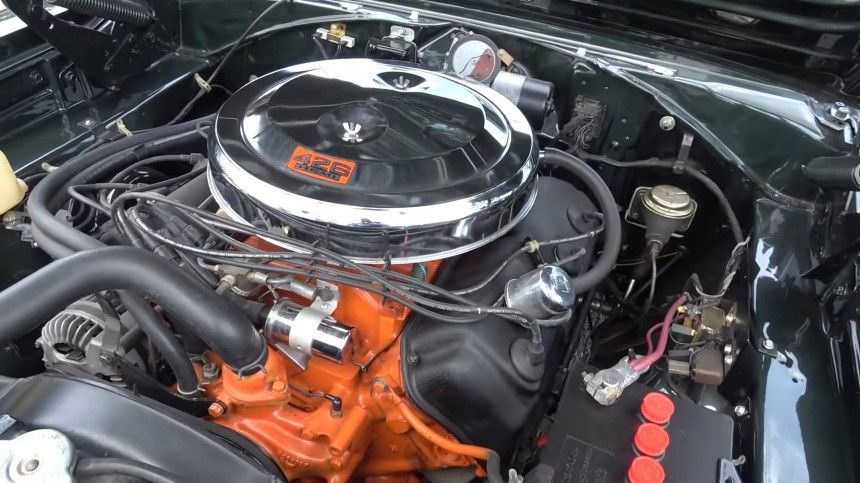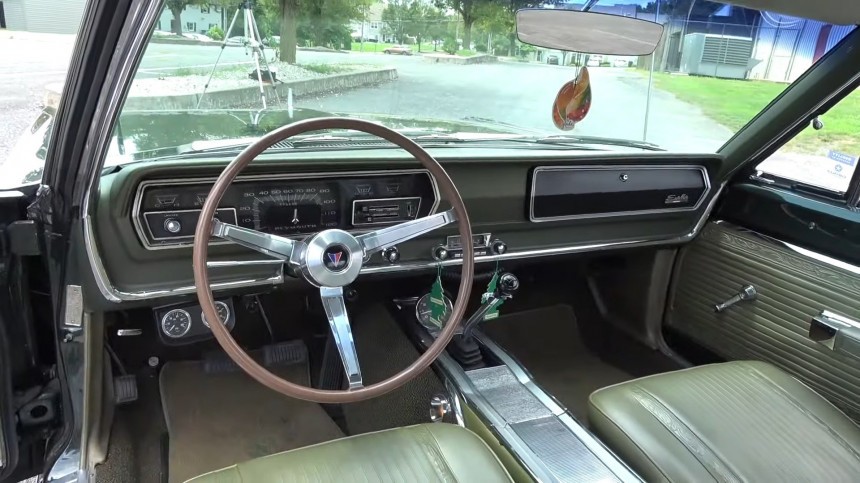“You get lucky once in a while, not very often.” This dictum is debatable, depending on one’s perspective and understanding of luck. But when the context involves owning an early 426 HEMI Mopar – the original, of course – consensus is unanimous. For this philosophical conundrum, let’s take the following Plymouth Satellite from 1966 and its numbers matching hypnotic 426 cubic-inch V8 with a close-ratio four-speed.
The quote at the opening of this story belongs to the owner of one of those legends. Right off the bat, die-hard Moparists will say that this car is one rare treat and a very desirable one at that. Being a 1966 model - the first year for the Street HEMI engine – and putting the 425 hp down via a four-speed manual transmission makes it one out of 503 hardtop Satellites built in this configuration. The Plymouth Satellite arrived a year earlier as a top-trim level for the Belvedere, and in 1966, Chrysler built 35,399 of them.
However, the corporation put its most notorious engine in only 817 plain-Jane-looking Satellites. Coincidentally, 1966 was HEMI’s great year, with 2,729 hemispherical combustion chambered big-blocks. Compare that to the 1967 production of the famed powerplant of just 213 units, and you get the big picture. Luckily, Chrysler made the wise decision to not ditch the moster engine after that sales flop from '67.
The infamously capable engine – a pretentious and finicky dragon – gained its celebrity at the racetracks. Richard Petty claimed his first Grand National title in 1964, riding the elephant engine's high(er)-performance variant. In 1965, the HEMI got excommunicated from NASCAR following a quarrel with Ford.
After being trashed by Dodges and Plymouths at Daytona – and the other tracks - FoMoCo protested the ‘race-only’ availability of the HEMI. At least, that’s the popular version of the story. The untold part is that Blue Oval also tried the same trick with their single overhead camshaft V8 – the famous Cammer – that NASCAR didn’t approve to take the fight to Chrysler. So, in 1965, both engines got sacked from the high-speed ovals.
Chrysler noted this and detuned the 550-hp race HEMI to a streetable variant – the 425-hp, 490 lb-ft (431 PS, 664 Nm) V8 that still thrills us. That started in 1966, and the legend lasted until 1971, when we all know what happened. The Clean Air Act and insurance premiums strangled performance, and the 426 cubic-inch (7.0-liter) HEMI was shelved forever.
Chrysler engineers had to turn some wrenches to turn the ‘King Kong’ championship-winning V8 into a regular day-in, day-out driver suitable for civilian (but not necessarily civilized) use. They achieved the corporation’s detuning goal by replacing a ram-type magnesium intake manifold with an aluminum non-ram model, scraping the aluminum cylinder heads with cast-iron counterparts, and installing two 625CFM Carter carbs instead of the Holleys. Shortening the camshaft's duration, taking down the compression ratio from 11.0 to 10.25, fitting cast iron exhaust headers instead of the fabricated steel, and providing for manifold heat also pulled the reins on the thoroughbred HEMI.
The addition of cast iron parts put a heavy load on the front axle of every car that housed the monster engine, and this Plymouth Satellite from 1966 is no stranger to that burden. But, unlike the later muscle cars equipped with the torque ogre, the car we can see in the video is one discrete self-contained sleeper.
Apart from two easy-to-miss ‘426 HEMI’ badges on the front fenders, just behind the wheel arches, only a most inconspicuous 426 scripting adorns the minuscule hood ornament. Nothing else gives this car away for what it is – an environmentalist’s nightmare.
Even though this particular example is as green as it gets, inside and out, Greenpeace would likely not propose it for a ‘Stop the global warming’ medal. But back in 1966, the icecaps were not the mainstream popstars of later years, so gearheads weren’t concerned about their HEMIs’ greenhouse effect. The major headache back then was the motor’s price. Factor this in: the standard Plymouth Satellite had a base price of $2,810 when new.
The HEMI option was a $1,105 affair – almost 40% of the cost of the regular car. With several other options, the grand total would go over $4,000 – a lot of money for a car with very little to offer. Even performance wasn’t enough to justify the price tag. The demand, however, was not for creature comforts and amenities coupled with the HEMI but for pure tire-shredding fun.
And tire-smoking it delivered – which wasn’t a difficult job at all, given the skinny 7.75x14 rubbers that weren’t particularly grippy. This was another downside of the Satellite – while it could go fast, it didn’t stop very well once it got rolling. The 11-inch (228 mm) drum brakes on all four corners did a great job at locking the wheels beyond any hope of controlling the car, which would turn into a sleigh with fish-tailing habits.
The car we see here has been restored meticulously – before the current owner purchased it, the green HEMI belonged to a restoration shop owner. That’s why it looks so good, and that’s the explanation behind the HEMI’s healthy heartbeat. The solid lifters play their part – the street HEMI was built in this architecture until 1967 – covering a broad range of noises and making the engine sound like there’s no oil pressure. Keeping it in tune (pun intended) required constant care and solid skill, and every so often, an owner would fail to adjust the HEMI to its optimal power band.
But when the engine got the needed attention and maintenance, it was an absolute weapon – and the owner of this lean green-on-green mean machine has a story to tell. The previous owner had warned about the car’s ‘rodeo act’ beyond second gear. Still, this Mopar enthusiast forgot all about it.
One day, while at the dragstrip, he put his foot down and went through the gears. First and second went well, but when the car hit 60 mph (97 kph) and he shifted into third, the entire audience gasped for air as the Satellite went sideways. Luckily, no harm was done to anyone or anything, and the HEMI returned to its trailer safe haven, where it lives to this day.
However, the corporation put its most notorious engine in only 817 plain-Jane-looking Satellites. Coincidentally, 1966 was HEMI’s great year, with 2,729 hemispherical combustion chambered big-blocks. Compare that to the 1967 production of the famed powerplant of just 213 units, and you get the big picture. Luckily, Chrysler made the wise decision to not ditch the moster engine after that sales flop from '67.
The infamously capable engine – a pretentious and finicky dragon – gained its celebrity at the racetracks. Richard Petty claimed his first Grand National title in 1964, riding the elephant engine's high(er)-performance variant. In 1965, the HEMI got excommunicated from NASCAR following a quarrel with Ford.
Chrysler noted this and detuned the 550-hp race HEMI to a streetable variant – the 425-hp, 490 lb-ft (431 PS, 664 Nm) V8 that still thrills us. That started in 1966, and the legend lasted until 1971, when we all know what happened. The Clean Air Act and insurance premiums strangled performance, and the 426 cubic-inch (7.0-liter) HEMI was shelved forever.
Chrysler engineers had to turn some wrenches to turn the ‘King Kong’ championship-winning V8 into a regular day-in, day-out driver suitable for civilian (but not necessarily civilized) use. They achieved the corporation’s detuning goal by replacing a ram-type magnesium intake manifold with an aluminum non-ram model, scraping the aluminum cylinder heads with cast-iron counterparts, and installing two 625CFM Carter carbs instead of the Holleys. Shortening the camshaft's duration, taking down the compression ratio from 11.0 to 10.25, fitting cast iron exhaust headers instead of the fabricated steel, and providing for manifold heat also pulled the reins on the thoroughbred HEMI.
Apart from two easy-to-miss ‘426 HEMI’ badges on the front fenders, just behind the wheel arches, only a most inconspicuous 426 scripting adorns the minuscule hood ornament. Nothing else gives this car away for what it is – an environmentalist’s nightmare.
Even though this particular example is as green as it gets, inside and out, Greenpeace would likely not propose it for a ‘Stop the global warming’ medal. But back in 1966, the icecaps were not the mainstream popstars of later years, so gearheads weren’t concerned about their HEMIs’ greenhouse effect. The major headache back then was the motor’s price. Factor this in: the standard Plymouth Satellite had a base price of $2,810 when new.
And tire-smoking it delivered – which wasn’t a difficult job at all, given the skinny 7.75x14 rubbers that weren’t particularly grippy. This was another downside of the Satellite – while it could go fast, it didn’t stop very well once it got rolling. The 11-inch (228 mm) drum brakes on all four corners did a great job at locking the wheels beyond any hope of controlling the car, which would turn into a sleigh with fish-tailing habits.
The car we see here has been restored meticulously – before the current owner purchased it, the green HEMI belonged to a restoration shop owner. That’s why it looks so good, and that’s the explanation behind the HEMI’s healthy heartbeat. The solid lifters play their part – the street HEMI was built in this architecture until 1967 – covering a broad range of noises and making the engine sound like there’s no oil pressure. Keeping it in tune (pun intended) required constant care and solid skill, and every so often, an owner would fail to adjust the HEMI to its optimal power band.
One day, while at the dragstrip, he put his foot down and went through the gears. First and second went well, but when the car hit 60 mph (97 kph) and he shifted into third, the entire audience gasped for air as the Satellite went sideways. Luckily, no harm was done to anyone or anything, and the HEMI returned to its trailer safe haven, where it lives to this day.



































